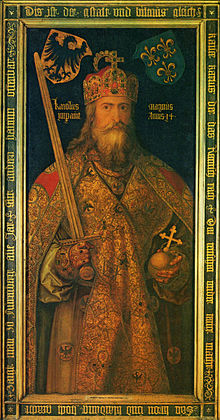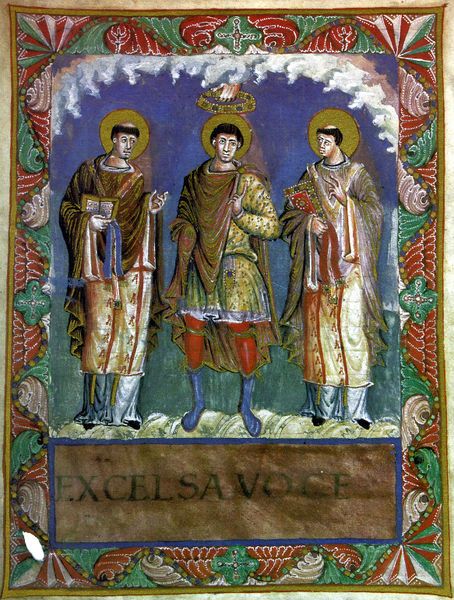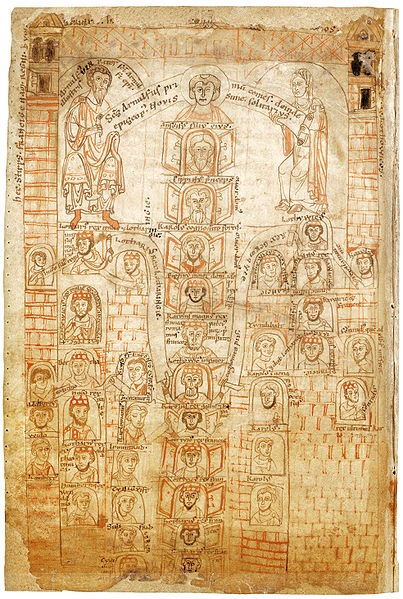Our story
This Chapter
|
|
 July 3, 2011 "Charlemagne was not unusually pious (he was rather earthy, and loved jokes, songs, sex, hunting and swimming, and roast meat—less so drinking, it is claimed), but he introduced an ecclesiastical and moralizing edge to political practice which lasted throughout the Carolingian century and beyond, and which had many ramifications," thus Chris Wickham in his The inheritance of Rome. We shall be interested in all three—the eclasiastical, the moral, and the political—because of their lasting influence. As for the military aspect of Charlemagne's rule, some notes under Temper of the times shall suffice. But first a few words about names. 3 Family names as we know them today were almost non-existent then. Many prominent families were known by the name of a recognized founder of their dynasty, or house. For example, Clovis I was a Merovingian so named after his shadowy grandfather Merovech.* The name Merovingian came into use not later than 640. Charlemagne was a Carolingian, a name that derives from Carolus, i.e. Charles Martel, his grandfather. 4  Charlemagne as depicted in 1512 by Albrecht Dürer with flowing blond hair, due to a misunderstanding of Einhard, who describes Charlemagne as having beautiful white hair, which has been rendered as blonde or fair in many translations. Charlemagne is said to prefer simple, plain clothes.* The German eagle is achronic. About earlier portraiture, the Roman tradition of realism was in complete eclipse in his time; instead individual traits were submerged in a typecastings that endowed the enthroned Charlemagne, God's representative on Earth, with the majesty of icons of Christ as shown in the next illustration. (Source) ¶ 5  Iconic representation of Charlemagne with Popes Gelasius I and Gregory I. From the sacramentary of Charles the Bald (ca. 870). Paris, Bibliothèque nationale de France, Département des Manuscrits. Charlemagne ruled from 768 till 814; Galasius's papacy ran from 492 till 496; Gregory's from 590 till 604. Excelsa voce = In emphatic voice. (Source) ¶ 6 The Carolingians and the papacy got on well together. Charles Martel's son Pippin the Short, who effectively ruled France under a Merovingian King, Childeric III, wrote then Pope Zacharias whether "in regard to the kings of the Franks who no longer possess the royal power: is this state of things proper?" upon which the pope replied that it was better to call him king who had the royal power than the one who did not. On behest of the pope, Pippin was henceforth anointed king by Boniface, the archbisshop of Mainz (752), symbolizing sacramental or divine influence. Thus Pippin gained in stature whereas the pope gained a militarily strong protector plus an extension of papal spiritual and temporal influence. Later, Peppin gained even greater stature by a second anointing, by the next pope, Stephen II, himself. Peppin's son, Charlemagne, born in 747, was anointed King of the Franks in 768. Charlemagne, too, was anointed a second time, in 800, but now as Emperor of the Romans.* His empire, by historians referred to as the Carolingian empire, was ostensibly a continuation of the Roman empire. By the hindsight of history, it is also seen as the forerunner of the Holy Roman Empire of which Otto I was the first emperor. 7  A Carolingian family tree, from the Chronicon Universale of Ekkehard of Aura, 12th century. (Source) ¶ 8 Charlemagne had an abundance of partners: ten on record.* Small wonder, therefore, that he is an ancestor of many families. But in the case of the Merckelbachs the descendance is not altogether patrilinear as we see under Roots. 9 He refused to allow his daughters to contract sacramental marriages—possibly to prevent the creation of cadet branches of the family to challenge the main line—yet he tolerated their extramarital relationships, even rewarding their common-law husbands, and he treasured his bastard grandchildren. He did not, or refused to, believe stories of their wild escapades. His son and successor, Louis the Pious, banished Charlemagne's surviving daughters from his court to take up residence in convents. At least one daughter, Bertha, had a recognised relationship, if not a marriage, with Angilbert, a member of Charlemagne's court circle, thus bringing to mind the legend of Emma and Eginhard told in Chapter 6.* Angilbert served Charlemagne as a diplomat, abbot, poet, and semi-son-in-law. Angilbert's non-sacramental relationship with Bertha was evidently recognized by the court. Control of marriage and the meanings of legitimacy were hotly contested in the Middle Ages. Bertha and Angilbert are an example of how resistance to the idea of a sacramental marriage could coincide with holding church offices. On the day of his death, Angilbert was venerated as a saint. The Catholic Encyclopedia informs us that in those days canonizations were very informal and involved little investigation of past conduct or virtue. 10 Charlemagne's native language is a matter of controversy. It was probably a Germanic dialect of the Ripuarian Franks and of which there is no written record. It is related to Dutch and modern dialects in the German North Rhineland, which modern linguists have dubbed Ripuarian. The names he gave his children are indicators of the language he spoke; all of his daughters received Old High German names. Apart from his native language he also spoke Latin "as fluently as his own tongue" and understood a bit of Greek. 11 Etc. Bibliography
Legend has it that Merovech is the offspring of his mother's chance encounter with a sea monster. It is said that this might be the origin of the notion that blue blood is a halmark of European nobility, same as for sea animals, believe it or not. According to his biographer Einhard (~775–840), Charlemagne wore the traditional, inconspicuous and distinctly non-aristocratic costume of the Frankish people, Next to his skin he wore a linen shirt and linen breeches, and above these a tunic fringed with silk; while hose fastened by bands covered his lower limbs, and shoes his feet. Winters, he wore a short, close-fitting coat of otter or marten skins. On special occasions, he wore fancy jewelled swords. He despised foreign costumes, however handsome, and never allowed himself to be robed in them, except twice in Rome, when he donned the Roman tunic, chlamys, and shoes; the first time at the request of Pope Hadrian, the second to gratify Leo, Hadrian's successor. On great feast days, he wore embroidery and jewels on his clothing and shoes. He had a golden buckle for his cloak on such occasions and would appear with his great diadem. (Source.) A snippet of history seems in order here. In 799, Pope Leo III had been mistreated by the Romans, who tried to put out his eyes and tear out his tongue. Leo escaped, and fled to Paderborn where he asked Charlemagne to intervene in Rome and restore him. Charlemagne agreed to travel to Rome. There, at Christmas mass, when Charlemagne knelt at the altar to pray, the pope crowned him Emperor of the Romans. In so doing, the pope was effectively attempting to transfer the office from Constantinople to Charles. Einhard says that Charlemagne was ignorant of the pope's intent and did not want any such coronation. Many modern scholars suggest that Charlemagne was well aware of the upcoming coronation. Charles then liked to be officially known as "Charles, most serene Augustus crowned by God, the great, peaceful emperor ruling the Roman empire" to the more direct "Emperor of the Romans." (Source.) Historian Wolfgang Menzel (1798–1873), in his Geschichte der Deutschen, wrote that Charlemagne was married five times and had five concubines. Derek Wilson, in his Charlemagne: Barbarian and Emperor, writes that one shouldn't really divide his many partners simply into wives and concubines because Frankish custom was less rigid and enabled the king to choose whom he would elevate to the position of official queen and thereby legitimate their joint offspring. Wolfgang Menzel again: "His secretary, young Eginhart, became deeply enamored of his daughter Emma, and the youthful lovers, fearing [Charlemagne's] anger should he discover their affection only met at night. It happened, that one night, whilst Eginhart was in the princess's apartment, a fall of snow took place. To return across the palace court must lead to inevitable discovery by the traces of his footsteps. The moment called for resolution; woman's with came to the assistance of the perplexed lover, and the faithful and prudent Emma, taking her lover on her back, bore him across the court. The emperor, who chanced to be gazing from his window. beheld this strange sight by the clear moonlight, and the next morning sent for the young couple, who stood before him in expectation of being sentences to death, when the generous father bestowed upon Eginhart his daughter's hand, and the Odenwald in fief. The tomb of Eginhart and Emma is still to be seen in Erbach. The counts of Erbach claim from them their descent. Eginhart became a celebrated historian, and it was chiefly through the medium of his pen that the deeds of his great father-in-law were handed down to posterity. Bertha, the second daughter, carried on a similar intrigue with young Engelbert ...."
As for Emma and Eginhart, Prof. A.J. Grant (1862–1948) writes in his Two lives of Charlemagne: "[Eginhard] married Imma, a Frankish lady of good family. (It is merely a stupid legend that makes her the daughter of Charlemagne.)" |
--
| top of page |
|
Page maintenance:
Page format:monh xx, 2015
Story edit:
To be checked for timeliness:
¶ none
Reminders:
¶ none
Linkcheck: not done
XHTML verify: not done
Backups: month. 25, 2011
